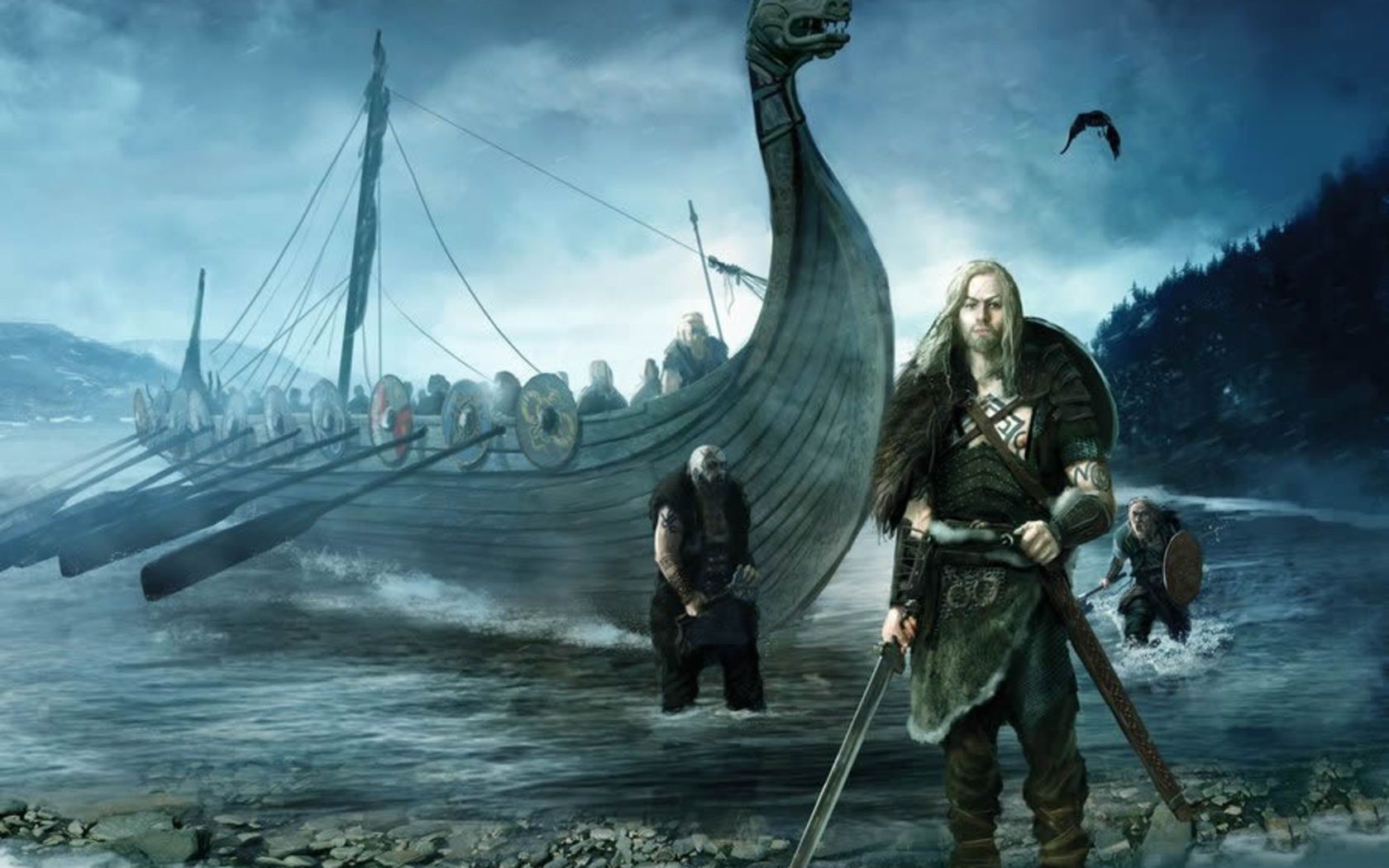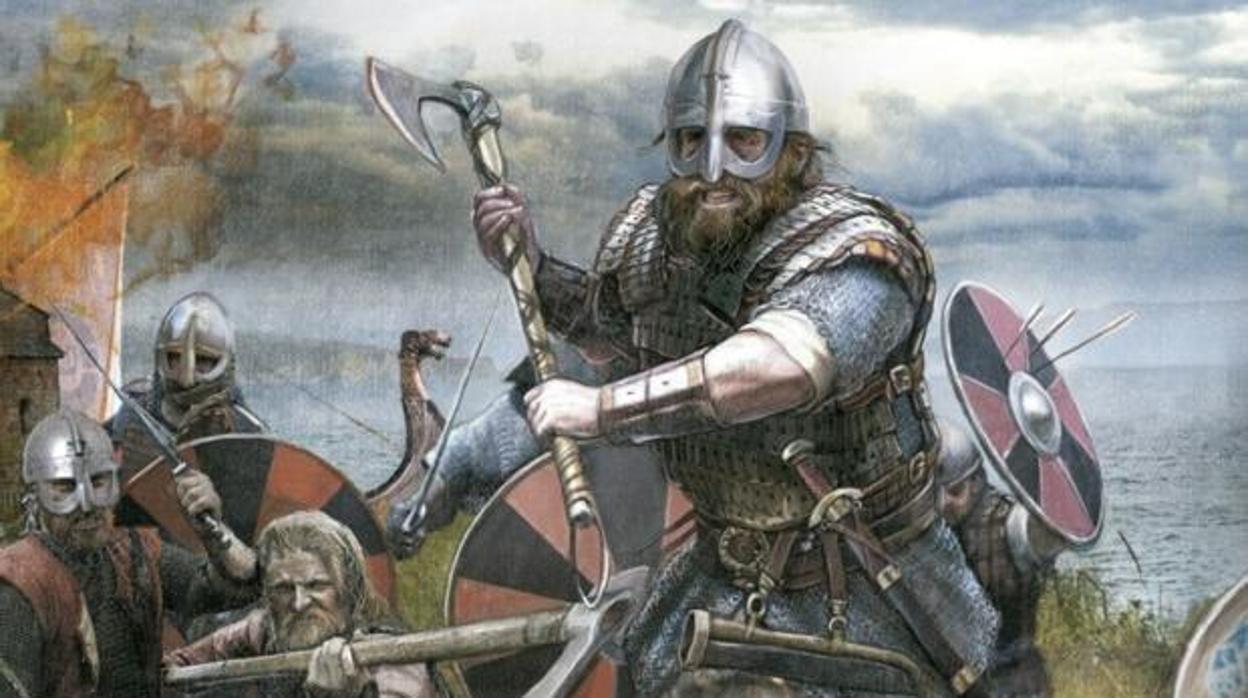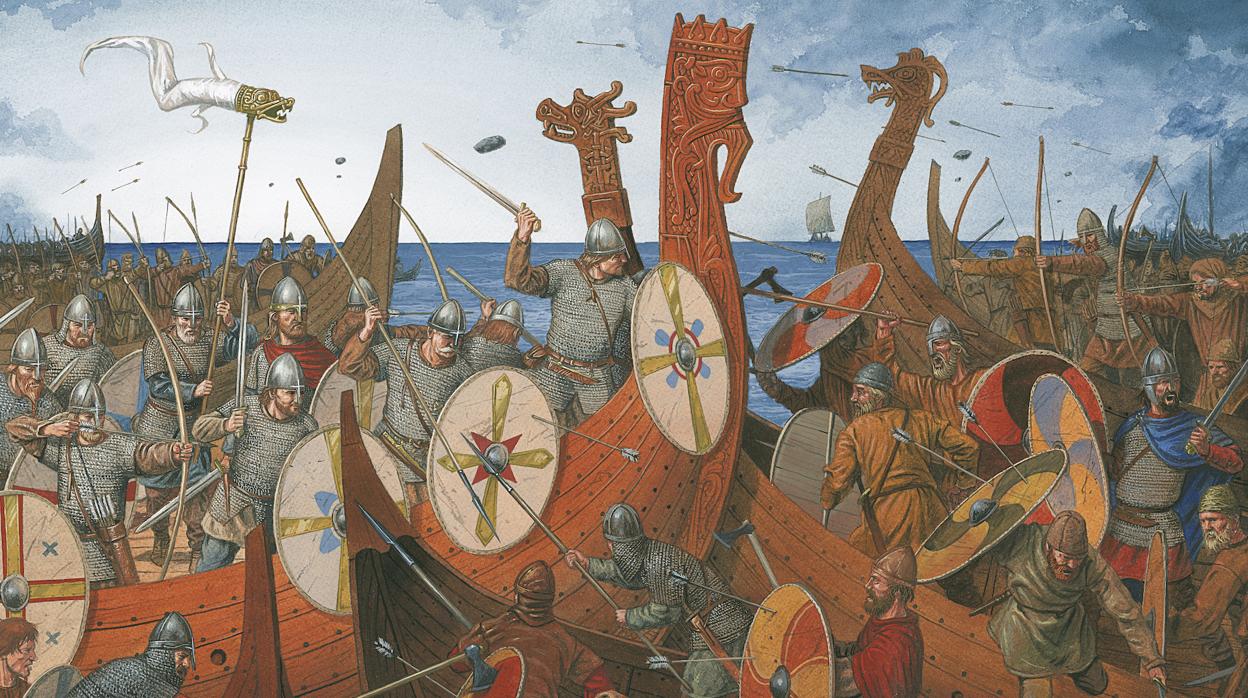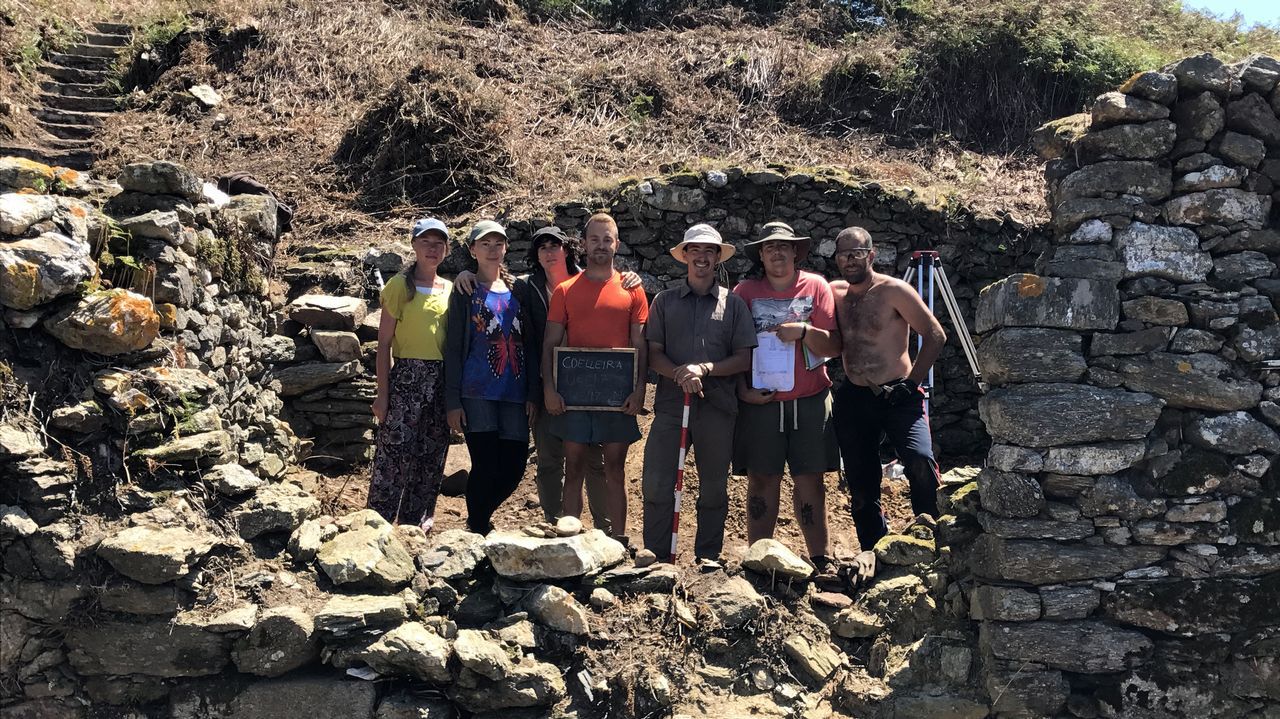Arab historians were the first to talk about the Vikings in Spain. In the year 844, between the end of July and the beginning of August, the Iberian Peninsula, witnessed the arrival of dozens of ships, it was one of the most epic expeditions in the history of Nordic navigators. This event marked the beginning of an era of invasions and looting in Spain by the feared Vikings.

The Viking Age in Spain
Between the ninth and tenth centuries, the Vikings invaded Spain. At that time, coexisted in the Iberian Peninsula Al Andalus and the ancient Christian kingdoms. Initially, the Normans found, on their way, the crowns Pamplona y Asturias, and part of the territory of the Carolingian empire, hispanic brand.
Later, in subsequent expeditions, they would reach the Kingdom of Leon. Between the first and the last invasion of the Vikings in Spain, more than a hundred years would pass. During this period of time, no notable changes occurred in the Peninsula, due to the fact that the Kingdom of Granada, the last Islamic bastion, would last until the last years of the fifteenth century.
The raids on Spain
The Vikings traveled to invade Spain in three historical moments: the initial, or "indirect penetration" in which they dedicated themselves to seeking information and trading slaves; after this there were two successive invasions in the ninth century, to Muslim Spain, and the tenth century, to Christian Spain, followed by a third stage of supposed settlement.
Bordering the Atlantic coast
Scandinavian explorers made their first expedition to Spain in the year 844. It was an attack on the Iberian Peninsula arriving at its Atlantic coast, and then they left for the Guadalquivir river.
A large fleet of Viking ships, which entered the south of France on the Garonne River, managed to reach the coast of Cantabria after a dangerous storm.
A hundred Viking ships that made up a fearsome fleet were sighted on August XNUMXst off the coast of Gijón. The Vikings refueled with water and left, without giving rise to any unfortunate incident.
Some days later, the Scandinavians would dedicate themselves to looting in the surroundings of La Coruna. In the end, this invasion culminates because the army of Ramiro I of Asturias defeat the Vikings, who are forced to return to their ships and leave.
This is the story that appears narrated in the “Castilian Annals Seconds”, Also known as Complutense Annals, these writings are a compilation of narratives, and they record this invasion as they perceived it in the Viking Age in Spain.
The objective of the Viking invasion
After the brief skirmish in La Coruna, the explorers find what they wanted in Lisbon. It is a big city, and they besieged it for thirteen days between August and September, this lasted until the Muslim troops came to drive them out. At that time the Vikings went to cross the Iberian coast towards the south, arriving at the Gulf of Cadiz.
managed to conquer CadizThey went up the river Guadalquivir, looting all the towns they found in their path, and murdering all the locals so that they would not alert them to their presence. After this, in the battle of cabtalThey defeated the Muslims.
Continuing their route down the river, the four thousand or so Vikings arrive at Isbiliya, Sevilla, for the last days of September. The inhabitants of SevillaThey fled in a panic Carmona, this narration is due to the Andalusian chronicler Ibn al-Qutiyya, which reflects it in his manuscript “History of the conquest of al-Andalus”.
After a few weeks, a troop arrived from Cordova, of about sixteen thousand men, sent by Abdullah II. This was the emir of Cordova, and put to command this army Musa ibn Musa al-Qasi, who was very famous and respected at the time.
The reaction of Al Andalus
the vikings in Spain They settled in a camp Tablada, and they were separated into four groups. A group, made up of 200 men, assaulted Hummock; the second, assaulted Benilaiz; the next assaulted Cantos Fountain; and the last one attacked Cordova.
The great army of Musa ibn Musa, exterminated the first group in the offensive of Hummock and took the fort Tablada, a thousand Scandinavians died there. The Muslims apprehended and executed another four hundred Vikings after these fights.
Most were beheaded, and “their heads hung from the palm trees of Seville”. Another group was buried alive, with their heads exposed, to be trampled to death by horses. On the other hand, they set fire to thirty Viking ships.
The Scandinavians who managed to escape, agreed for clothing, food and to be able to retreat to the coast, in exchange for returning the hostages and the loot they took. Mistreated as they were, these survivors fled across the Mediterranean, ravaging Byzantine lands until they reached Alexandria.
Some prisoners were not executed, who converted to Islam, and these Vikings in Spain they supposedly settled on farms. In the aftermath of the attack, Abdullah II, reassessed and reinforced Seville, to improve its defenses, and built ships to defend the coast of Al Andalus.
A communications system on horseback was also installed to be able to alert quickly when invaders arrived. If you are interested in learning about the mythological beliefs of other cultures, we invite you to read wood nymphs.
Björn Ragnarsson's Expedition
The second time the Vikings were seen in Spain, the expedition was commanded Bjorn Ragnarsson, which was known as Iron Side. Son of Ragnar Lothbrok, who took about a hundred ships, and with this fleet headed for the Iberian Peninsula.
It was the year 858, the fleet of Bjorn sailed down the estuary Arosa, going to Santiago de Compostela, upon arrival they put this walled city under siege. Despite the Christians paying tribute to them to leave, the Vikings maintained the siege.
From Asturias, the king Ordoño I, sent troops, commanded by the count Peter Theon, this defeats the invaders, and of the Viking fleet composed of one hundred ships, only 62 managed to escape.
After this defeat inflicted on the Vikings in Christian lands, the Scandinavian ships headed south. They tried to land on the Portuguese coast, but they failed, they lost two ships there, the other sixty arrived at Algeciras. In this city they looted, and destroyed the mosque.
They then left and entered the North of Africa, this before invading the islands Balearics y Orihuela, arriving by the river Segura. They retreated to the French shores for the winter, and then headed to Italy.
The capture of the king of Pamplona
Some time later, the son of Ragnar would return to Spanish lands. The ships of bjon Ragnarsson they went up the river ebro, reaching up to Pamplona. Once there they captured the king Garcia Iniguez of Pamplona, who had to pay a ransom of 70000 gold coins to obtain his freedom.
the vikings in Spain, rarely applied the so-called Danish tax, which consisted of charging an extortion to pass by and not loot the town. One of the documented cases is the rescue of the king of Pamplona. This practice over time became common in other kingdoms also devastated by the Viking hosts.
After this success, this second wave of Vikings in Spain, suffered a huge setback. Crossing the Strait of Gibraltar to return home, Bjorn he met the fleet of the Cordovan emir.
In this skirmish, the Vikings lose approximately 40 ships. The escaped ships came home in 862, with enormous riches. To learn more about other interesting warrior cultures, follow the link below mayan legends.
the last stage
The next and last invasion of the Vikings in Spain, begins in the year 966. This was different from the previous ones, in this one several invasion attempts were made. A small Viking fleet is seen in Alcácer do Sal, on the sides of Lisbon, had only twenty-eight ships.
They clashed with the local armies and the Scandinavians won, they captured a large number of prisoners. Immediately, they were hunted down by sea from Seville and some of the prisoners were recovered. This success dealt a heavy blow to Viking morale.
Two years later, the leader Gundraed goes up the estuary with 100 ships to invade Santiago de Compostela. The defense troops were headed by Bishop sisnando, are defeated in ovens and they lose their commander. The next three years were spent plundering, by the Vikings, without any opposition.
In 971, the kingdom of Asturias faces them. The troops were led by Bishop rudesindo and for the count Gonzalo Sanchez, This army prevails over the Vikings in a great battle, killing Gundraed.
After a few months, a large fleet headed towards Lisbon, with the intention of invading in search of riches. What they did not count on was that the years of looting and invasions had left a good apprenticeship in the Andalusians, who joined the fleets of the Atlantic and the Mediterranean coast and went out to meet the Vikings.
In this way the last attempt of the Vikings to continue devastating the Iberian Peninsula, thus closing a period of uncontrolled violence and looting that left deep marks on both cultures.
Viking settlements in Spain
Despite everything, the Vikings failed to hit Spain in the same magnitude as England o France. They failed to establish colonies, nor did they manage to penetrate the Spanish culture.
There are theories that ensure that there were no Viking settlements in Spain. However, in a place Galicia, they found archaeological remains that are similar to the transitory camps, which the Scandinavians installed during their incursions into foreign lands.
This possible Scandinavian settlement is located in The Mountillos, near the beach Saint Roman, riding a Vicedo Lugo. Researchers are still excavating and analyzing the site. Until now it is the only one that has been found, but this does not rule out that there are more.
At the beginning of this discovery, it was speculated that this site could be a fort, but everything seems to indicate that it is a temporary Norman seat, similar to those found in England. Which consists of a raised mound with a wall and a moat.
The main objective of the Viking expeditions was looting and capturing slaves, when they traveled it was not with the intention of settling down, much less being farmers. This is perhaps the reason why no major samples have been found of the passage of the Vikings' stay in Spain.
As the custom was to arrive, burn and pillage, it was very unlikely that the Vikings in Spain, they will be busy building very complicated and durable structures.
Evidence of settlements VIkings in Spain
It must be borne in mind that the presence of other Viking places in Spain. In the rest of the peninsula, of course, there may be more of them.
There is news of other places where they possibly settled, but since they were constructions designed to last a short time, their permanence and conservation over time are unlikely, it should be noted that they used to build a settlement in four or five days.
Another aspect to take into account is geographical onomastics, it is worth studying the etymology of the proper names of the place. In the region of the province of Lugo, there are many mounds on the ground, and they are called “specks”, this word is known to come from the Nordic language, in it you can see the resemblance to the term Motte & Bailey, which is used to refer to fortifications located on hills.
In general, all the bibliographic reference that exists on the Vikings in Spain, and more exactly in Galicia, is made up of very old works, with a very partial approach, full of contradictions, as well as allusions to the supernatural.
This makes it extremely difficult to verify the passage of the Scandinavians through the Iberian Peninsula, since the data does not have sufficient historical support for its verification. They are works from the XNUMXth century, which in a very traditional way present the facts with a vision that contrasts with the ideas provided by the most recent research on the Viking world in the north of Europe.
In any case, they present data of great interest and importance to be able to spin the story, how was the presence of the Vikings in Spain, and could eventually help locate other settlements. If you want to know more about the Vikings, we invite you to read viking symbols.





